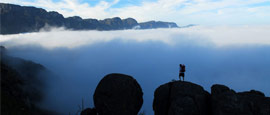Travel to Cape Town
Flying to Cape Town
Airlines that fly to Cape Town include British Airways, Emirates, Ethiopian Airlines, KLM, Lufthansa, Qatar Airways, Singapore Airlines and South African Airways, among others. Flights to the southern hemisphere during summer months (between December and March) are usually more expensive.
From the UK, British Airways offers direct flights to Cape Town.
No direct flights from the USA to Cape Town, but you can connect via Johannesburg with South African Airways or via Dubai with Emirates.
From London - 11 hours 30 minutes; New York - 19 hours (including stopover); Los Angeles - 27 hours (including stopover); Toronto - 22 hours (including stopover);Sydney - 18 hours 30 minutes (including stopover).
Website:capetown-internationalairport.co.za
Location:
Cape Town International Airport is located 18km (11 miles) east of Cape Town.
Money:
Bureau de change and ATMs are available in both terminals. There is a full-service bank in the international departures area.
Luggage:
A-Teck offers a baggage storage service and a baggage wrap service at the airport (tel: +27 72 384 2954). A porter service is available; porters, who are dressed in black and orange, are self-employed and rely on tips for their income.
Travel by road
The Cape's stunning scenery, good-quality roads and dearth of public transport make driving the best option. Just be careful - the country has a high accident rate, clueless drivers who flout the rules, and a lax attitude to drink-driving. The legal driving age is 18 years, though car hire companies often require drivers to be at least 21 and may have a surcharge on under 25s.
Driving is on the left. The speed limit on highways is 120kph (75mph), 80-100kph (50-62mph) on national roads and 60kph (37mph) in urban areas. Foreign licences are valid if they are in English with a photograph of the holder, but the AA recommends an International Driving Permit to prevent potential complications. You must carry your licence at all times. Car theft and hijacking is a problem in some areas, so listen to local advice, keep doors locked and avoid hitchhikers. Note that some petrol stations may only accept cash, not credit cards.
The main motoring organisation in South Africa is the AA (tel: +27 861 000 234; www.aa.co.za).
The AA (tel: 0861 000 234, in South Africa only). Yellow SOS telephones are available on major routes.
Three main routes lead into Cape Town: the N1 from Johannesburg via the Winelands of Paarl and Franschhoek; the N2 weaving along the coastal Garden Route and from the airport; and the N7 from Namibia down the west coast.
From Johannesburg - 14 hours; Durban - 16 hours; Franschhoek - 1 hour; Stellenbosch - 40 minutes.
Air-conditioned coaches run from Adderley Street Station to cities including Johannesburg, Durban, Port Elizabeth, Pretoria and Upington, and internationally to Bulawayo and Harare in Zimbabwe, Maputo in Mozambique, Windhoek in Namibia and also to Zambia, Malawi and Botswana.
Operators include Intercape (tel: +27 21 380 4400; www.intercape.co.za), Greyhound (tel: +27 11 611 8000; www.greyhound.co.za), and Translux (tel: +27 861 589 282; www.translux.co.za). The Baz Bus (tel: +27 21 422 5202; www.bazbus.com) is aimed at backpackers and picks up from hostels en route. It runs along the coast between Cape Town and Durban, before heading to the Drakensberg Mountains and Johannesburg.
Travel by rail
South Africa’s lack of public transport is apparent in its train services – or relative lack of them. On a positive note, Cape Town’s main Adderley Street Station has been modernised with shops, cafés, and information kiosks.
Standard trains (tel: + 27 860 008 888; www.shosholozameyl.co.za) run to Johannesburg twice a week via Kimberley with sleeper service and dining cars.
Of most interest for tourists is the Southern Suburbs Line run by Metrorail Western Cape (tel: +27 800 656 463; www.capemetrorail.co.za). As much about the journey as the destination, this route runs along the rugged coastline from Cape Town's Adderley Street Station and stops at the coastal towns of Observatory, Newlands, Muizenberg, Kalk Bay, Fish Hoek and Simon's Town. A hop-on, hop-off daily pass lets you jump off at each station.
The luxurious Blue Train (tel: +27 21 449 2672; www.bluetrain.co.za) and its rival Rovos Rail (tel: +27 21 421 4020; www.rovosrail.co.za) run one- and two-night trips between Cape Town and Pretoria four to six times a month. Evoking a bygone era, the experience of gently rocking through spectacular countryside and indulging in fine food and wine makes this a must for rail buffs.
Metrorail's Premier Classe (tel: +27 11 773 9247; www.premierclasse.co.za) runs once a week each way to Johannesburg, and offers luxury cabins with gourmet five-course dinners and high teas.
From Johannesburg - 25 hours; Pretoria - 27 hours 30 minutes.
Travel over water
If you fancy a cruise to Cape Town, arriving by ship is truly spectacular, with Table Mountain as the backdrop to the picturesque harbour.
Cruise companies such as Cunard, P&O, Silversea, Princess Cruises and smaller vessels such as the National Geographic Orion are among the operators which berth at the Port of Cape Town and Duncan Dock, which are close to the city centre. Plans for a new luxury cruise ship terminal were approved in 2015.
Cape Town.
Duncan Dock is about 5km (3.1 miles) from the city centre and can be reached within 10 to 15 minutes by taxi.
Do you have any Feedback about this page?
© 2026 Columbus Travel Media Ltd. All rights reserved. No part of this site may be reproduced without our written permission, click here for information on Columbus Content Solutions.








 You know where
You know where